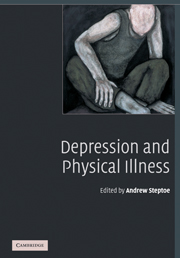Crossref Citations
This Book has been
cited by the following publications. This list is generated based on data provided by Crossref.
Zautra, Alex J.
Parrish, Brendt P.
Van Puymbroeck, Christina M.
Tennen, Howard
Davis, Mary C.
Reich, John W.
and
Irwin, Mike
2007.
Depression History, Stress, and Pain in Rheumatoid Arthritis Patients.
Journal of Behavioral Medicine,
Vol. 30,
Issue. 3,
p.
187.
2008.
Book received.
Psychological Medicine,
Vol. 38,
Issue. 6,
p.
903.
Steptoe, Andrew
Dockray, Samantha
and
Wardle, Jane
2009.
Positive Affect and Psychobiological Processes Relevant to Health.
Journal of Personality,
Vol. 77,
Issue. 6,
p.
1747.
Zanuso, Silvano
Balducci, Stefano
and
Jimenez, Alfonso
2009.
Physical activity, a key factor to quality of life in type 2 diabetic patients.
Diabetes/Metabolism Research and Reviews,
Vol. 25,
Issue. S1,
Matthews, Scott C.
and
Lane, Richard D.
2010.
Handbook of Behavioral Medicine.
p.
803.
Bennett, Paul
2010.
Cardiac Rehabilitation Manual.
p.
61.
Nam, Hyun-Yeol
Song, Sang Heon
Kim, Seong-Jang
Kwak, Ihm Soo
Kim, In Joo
Lee, Soo Bong
Lee, Dong Won
Kim, Bum Soo
Pak, Kyoungjune
Kim, Yong-Ki
and
Yun, Hyun Sil
2011.
Effect of dialysis on cerebral blood flow in depressive end-stage renal disease patients.
Annals of Nuclear Medicine,
Vol. 25,
Issue. 3,
p.
165.
Sacco, William P.
Bykowski, Cathy A.
and
Mayhew, Laura L.
2013.
Pain and Functional Impairment as Mediators of the Link between Medical Symptoms and Depression in Type 2 Diabetes.
International Journal of Behavioral Medicine,
Vol. 20,
Issue. 1,
p.
22.
Markwick, Alison
Ansari, Zahid
Sullivan, Mary
Parsons, Lorraine
and
McNeil, John
2014.
Inequalities in the social determinants of health of Aboriginal and Torres Strait Islander People: a cross-sectional population-based study in the Australian state of Victoria.
International Journal for Equity in Health,
Vol. 13,
Issue. 1,
Cameron, David S.
Bertenshaw, Emma J.
and
Sheeran, Paschal
2015.
The impact of positive affect on health cognitions and behaviours: a meta-analysis of the experimental evidence.
Health Psychology Review,
Vol. 9,
Issue. 3,
p.
345.
Lethin, Connie
Renom-Guiteras, Anna
Zwakhalen, Sandra
Soto-Martin, Maria
Saks, Kai
Zabalegui, Adelaida
Challis, David J
Nilsson, Christer
and
Karlsson, Staffan
2017.
Psychological well-being over time among informal caregivers caring for persons with dementia living at home.
Aging & Mental Health,
Vol. 21,
Issue. 11,
p.
1138.
Cheung, Gary
and
Sundram, Frederick
2017.
Understanding the Progression from Physical Illness to Suicidal Behavior: A Case Study Based on a Newly Developed Conceptual Model.
Clinical Gerontologist,
Vol. 40,
Issue. 2,
p.
124.
Quartilho, Manuel João R.
2018.
Legitimidades da loucura: sofrimento, luta, criatividade e pertença.
p.
59.
Raut, Nilesh
2018.
Universal Healthcare Coverage and Subjective Wellbeing: Evidence From Massachusetts Healthcare Reform.
SSRN Electronic Journal ,
Byrne, Eleanor Alexandra
2020.
Striking the balance with epistemic injustice in healthcare: the case of Chronic Fatigue Syndrome/Myalgic Encephalomyelitis.
Medicine, Health Care and Philosophy,
Vol. 23,
Issue. 3,
p.
371.
Owari, Go
Kono, Kenichi
and
Nishida, Yusuke
2021.
Depressive Symptoms and Associated Factors in Older Rehabilitation Inpatients: A Cross-Sectional Study.
Physical & Occupational Therapy In Geriatrics,
Vol. 39,
Issue. 4,
p.
387.
Oudin Doglioni, Damien
Chabasseur, Vincent
Barbot, Frédéric
Galactéros, Frédéric
and
Gay, Marie-Claire
2021.
Depression in adults with sickle cell disease: a systematic review of the methodological issues in assessing prevalence of depression.
BMC Psychology,
Vol. 9,
Issue. 1,
Malik, Jakub
and
Maciaszek, Janusz
2022.
Effect of the Juggling-Based Motor Learning Physical Activity on Well-Being in Elderly: A Pre–Post Study with a Special Training Protocol.
Healthcare,
Vol. 10,
Issue. 12,
p.
2442.
Black, Jacqueline
Sweeney, Louise
Yuan, Yuhan
Singh, Harinder
Norton, Christine
and
Czuber‐Dochan, Wladyslawa
2022.
Systematic review: the role of psychological stress in inflammatory bowel disease.
Alimentary Pharmacology & Therapeutics,
Vol. 56,
Issue. 8,
p.
1235.
Dempsey, Maria
Foley, Sarah
Frost, Nollaig
Murphy, Raegan
Willis, Niamh
Robinson, Sarah
Dunn-Galvin, Audrey
Veale, Angela
Linehan, Carol
Pantidi, Nadia
and
McCarthy, John
2022.
Am I lazy, a drama queen or depressed? A journey through a pluralistic approach to analysing accounts of depression.
Qualitative Research in Psychology,
Vol. 19,
Issue. 2,
p.
473.





